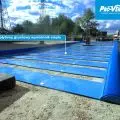Iga Ostrowska, observing Berlin's cooperatives and settlements centered around neighborhood spaces, created a project for a community development in Praga Północ. The concept integrating the residents of Warsaw is a thesis created at the Warsaw University of Technology under the direction of Katarzyna Kierczyńska-Królikowska.
A lack of interpersonal relationships can cause people to experience excessive stress, a growing sense of loneliness and isolation, as well as anxiety and depression. However, a well-designed space can serve to reintegrate a community.
Courtyards are communal spaces designed for, among other things, community gardens and cafes
© Iga Ostrowska
According to Iga Ostrowska:
Casual encounters and interactions are often underestimated, but they are an essential element for establishing social relationships. Environments designed to encourage people to interact help them accept its other users, and a mundane conversation with a stranger can become the beginning of a long-term friendship. A person's desire to be with other people, to connect with, care for and accept others falls into the category of needs necessary for happiness. Shared space is a factor that provokes getting to know others, having discussions and making compromises. The chance to undertake joint projects leads to cooperation and increased social trust. Areas that strengthen the sense of belonging are considered one of the ingredients that create a sense of metaphorical home.
Guided by these assumptions, the author created a conceptual design for a community development, combining newly designed structures with the existing neighborhood, choosing Warsaw's Praga Północ district as its site.
The architect proposed three types of residential development: Neighborhood Module, Cluster House and Coliving
© Iga Ostrowska
a city created by its residents
The city lives thanks to its residents, and they co-create it by leaving traces of their activity in the space
I. Calvino, Invisible Cities, W.A.B. Publishing House, Warsaw, 2013, p. 13
The concept was created on the basis of the experience that Iga Ostrowska gained during a couple of months of student exchange with TU Berlin. During that time, she took part in the MakeCity Festival, visiting numerous housing cooperatives and neighborhoods centered around neighborhood spaces, having the opportunity to interview both their architects and residents.
Openings in the ground floor block provide access to interconnected courtyards
© Iga Ostrowska
The author's main goal was to create a neighborhood in which the balance of private and common space is intended to provoke casual encounters and encourage residents to engage in common activities. The development consists of eight buildings composed along a walkway, which is the core for open neighborhood spaces and brings urban traffic into the neighborhood. The designed structure fills a void in the spatial fabric of Warsaw's Praga district and shapes the frontage of Solidarności Avenue, while creating a pedestrian-friendly space by providing a shortcut through the quarter. The form of the buildings corresponds to contemporary residential neighborhoods, while the service first floors arrange a sequence of interconnected intimate courtyards, referring to the courtyards of Prague tenements.
community development and neighborhood modules
An important aspect of the project was the profiling of the residential offer. The architect proposed three types of community developments. She took into account the diversity and needs of users from different age, professional and social groups, as well as nomadic lifestyles. Two buildings complementing the Solidarności Avenue frontage are designed for people combining residence with work. Common spaces used as offices are complemented by the offer of extensive coworking space located just above the service first floors.
The buildings have been designed on a similar structural module
© Iga Ostrowska
Five residential buildings make up the Neighborhood Module, consisting of an area-diverse offering of ownership apartments and neighborhood integration spaces. The buildings are designed on the same structural module, allowing them to be created and expanded as more communities are formed. Each Neighborhood Module is financed and managed by a separate co-op.
Cluster House is the central building of the premise, distinguished from others by both its form and purpose. It includes small apartments for singles or couples, available for long-term lease. These apartments are an option for digital nomads, those taking their first steps into adulthood or those not interested in home loans. The buildings' two-story common areas allow both integration of neighbors from the same floor and connected floors. The proportions of neighborhood spaces vary depending on the type of building.
types of neighborhood spaces
© Iga Ostrowska
neighborhood space
The composition of the development provides a frame for common recreational areas. The core is formed by a square supporting the current function of the area and a woonerf ringed by numerous services in the first floors of the buildings. Wide openings in the ground-floor mass suggest access to further interconnected public courtyards. These courtyards, which include cafes, community gardens and space for the youngest, respond to a variety of demands and integrate residents. The urban planning and architectural solutions adopted serve to shape a new neighborhood center in Warsaw, fulfilling the ideas contained in the Housing2030 program.
The project made it to the finals of this year's Zbyszek Zawistowski "Diploma of the Year" Award, the results of which will be announced in October. In addition to Iga Ostrowska, the nominees for the award include: Konrad Lepak with a design for a hotel on the Solina Reservoir, Martyna Mazurek author of a rotating skyscraper , and Adriana Sowa with a design for a Herbarium.
compiled by: Dobrawa Bies
illustrations courtesy of Iga Ostrowska











































